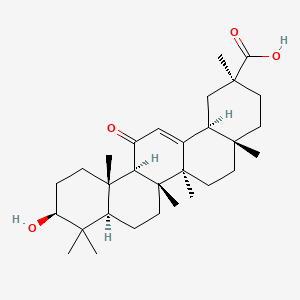| Authors | Title | Published | Journal | PubMed Link |
|---|---|---|---|---|
| Zhu Y et al. | Connexin 43 Mediates White Adipose Tissue Beiging by Facilitating the Propagation of Sympathetic Neuronal Signals. | 2016 | Cell Metab. | pmid:27626200 |
| Kim YJ et al. | Prevention of cisplatin-induced ototoxicity by the inhibition of gap junctional intercellular communication in auditory cells. | 2014 | Cell. Mol. Life Sci. | pmid:24623558 |
| Tabuchi M et al. | The blood-brain barrier permeability of 18β-glycyrrhetinic acid, a major metabolite of glycyrrhizin in Glycyrrhiza root, a constituent of the traditional Japanese medicine yokukansan. | 2012 | Cell. Mol. Neurobiol. | pmid:22488528 |
| Sato T et al. | Effect of gap junction blocker beta-glycyrrhetinic acid on taste disk cells in frog. | 2009 | Cell. Mol. Neurobiol. | pmid:19145483 |
| Guillotin B et al. | Human primary endothelial cells stimulate human osteoprogenitor cell differentiation. | 2004 | Cell. Physiol. Biochem. | pmid:15319536 |
| Li XD et al. | Panax notoginseng saponins potentiate osteogenesis of bone marrow stromal cells by modulating gap junction intercellular communication activities. | 2010 | Cell. Physiol. Biochem. | pmid:21220939 |
| Yamanouchi K et al. | 18alpha-glycyrrhetinic acid induces phenotypic changes of skeletal muscle cells to enter adipogenesis. | 2007 | Cell. Physiol. Biochem. | pmid:17982260 |
| Sun W et al. | Design, synthesis, and sustained-release property of 1,3-cyclic propanyl phosphate ester of 18β-glycyrrhetinic acid. | 2011 | Chem Biol Drug Des | pmid:21244638 |
| Chadjichristos CE et al. | Targeting connexin 43 prevents platelet-derived growth factor-BB-induced phenotypic change in porcine coronary artery smooth muscle cells. | 2008 | Circ. Res. | pmid:18239136 |
| He B et al. | Tramadol and flurbiprofen depress the cytotoxicity of cisplatin via their effects on gap junctions. | 2009 | Clin. Cancer Res. | pmid:19723651 |
| Princen F et al. | A cell type-specific and gap junction-independent mechanism for the herpes simplex virus-1 thymidine kinase gene/ganciclovir-mediated bystander effect. | 1999 | Clin. Cancer Res. | pmid:10589781 |
| Piao H et al. | Effects of connexin-mimetic peptides on perfusion pressure in response to phenylephrine in isolated, perfused rat kidneys. | 2011 | Clin. Exp. Nephrol. | pmid:21153751 |
| Nejime N et al. | Possible participation of chloride ion channels in ATP release from cancer cells in suspension. | 2009 | Clin. Exp. Pharmacol. Physiol. | pmid:18986334 |
| Goto K et al. | Critical role of gap junctions in endothelium-dependent hyperpolarization in rat mesenteric arteries. | 2002 | Clin. Exp. Pharmacol. Physiol. | pmid:12060103 |
| Yadav DK et al. | Design, synthesis and in vitro evaluation of 18β-glycyrrhetinic acid derivatives for anticancer activity against human breast cancer cell line MCF-7. | 2014 | Curr. Med. Chem. | pmid:24180274 |
| Bertuzzi F et al. | Mechanisms of coordination of Ca2+ signals in pancreatic islet cells. | 1999 | Diabetes | pmid:10512361 |
| Yu J et al. | Endometrial Stromal Decidualization Responds Reversibly to Hormone Stimulation and Withdrawal. | 2016 | Endocrinology | pmid:27035651 |
| Verma V et al. | Perturbing plasma membrane hemichannels attenuates calcium signalling in cardiac cells and HeLa cells expressing connexins. | 2009 | Eur. J. Cell Biol. | pmid:18951659 |
| Perez Velazquez JL et al. | Role of gap junctional coupling in astrocytic networks in the determination of global ischaemia-induced oxidative stress and hippocampal damage. | 2006 | Eur. J. Neurosci. | pmid:16420410 |
| Matsumoto T et al. | The anti-ulcer agent, irsogladine, increases insulin secretion by MIN6 cells. | 2012 | Eur. J. Pharmacol. | pmid:22542662 |
18alpha-glycyrrhetinic acid
18alpha-glycyrrhetinic acid is a lipid of Prenol Lipids (PR) class. 18alpha-glycyrrhetinic acid is associated with abnormalities such as Wiskott-Aldrich Syndrome. The involved functions are known as inhibitors, salivary gland development and branching morphogenesis.
Cross Reference
Introduction
To understand associated biological information of 18alpha-glycyrrhetinic acid, we collected biological information of abnormalities, associated pathways, cellular/molecular locations, biological functions, related genes/proteins, lipids and common seen animal/experimental models with organized paragraphs from literatures.
What diseases are associated with 18alpha-glycyrrhetinic acid?
18alpha-glycyrrhetinic acid is suspected in and other diseases in descending order of the highest number of associated sentences.
Related references are mostly published in these journals:
| Disease | Cross reference | Weighted score | Related literature |
|---|
No disease MeSH terms mapped to the current reference collection.
PubChem Associated disorders and diseases
What pathways are associated with 18alpha-glycyrrhetinic acid
There are no associated biomedical information in the current reference collection.
PubChem Biomolecular Interactions and Pathways
Link to PubChem Biomolecular Interactions and PathwaysWhat cellular locations are associated with 18alpha-glycyrrhetinic acid?
There are no associated biomedical information in the current reference collection.
What functions are associated with 18alpha-glycyrrhetinic acid?
Related references are published most in these journals:
| Function | Cross reference | Weighted score | Related literatures |
|---|
What lipids are associated with 18alpha-glycyrrhetinic acid?
There are no associated biomedical information in the current reference collection.
What genes are associated with 18alpha-glycyrrhetinic acid?
There are no associated biomedical information in the current reference collection.
What common seen animal models are associated with 18alpha-glycyrrhetinic acid?
There are no associated biomedical information in the current reference collection.
